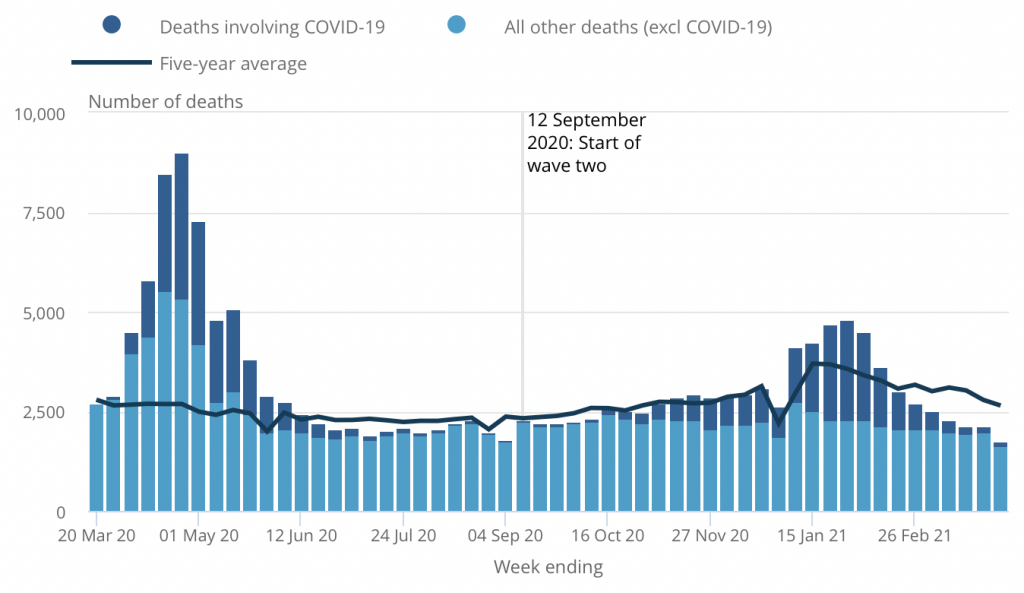Contrary to popular understanding, Britain’s second wave of COVID-19 was less deadly than the first: although there were more deaths within 28 days of a positive test, age-adjusted excess mortality was lower.
One possible explanation is that fewer people were infected in the second wave (even though the infection fatality rate remained constant). However, data from the Coronavirus Infection Survey suggests that roughly the same number of people were infected in the two waves. About 7% of people had antibodies at the end of the first wave, and about 14% had antibodies toward the end of the second wave (before the vaccination program had gotten fully underway).
Incidentally, some people may have been infected without developing antibodies. I’m using the number who developed antibodies as a proxy for the total number who were infected in each wave.
Another possible explanation is that we became better at treating the illness. Evidence suggests that thousands of lives were saved by corticosteroids like dexamethasone, but these may not have been widely used in the first wave. Yet another explanation is simply that there were fewer frail elderly people alive at the beginning of the second wave, meaning that the average elderly person who became infected was less likely to die from the disease.
However, there’s possibly a fourth reason why the second wave was less deadly than the first, namely that care homes achieved a degree of focused protection.
In the first wave, a disproportionate number of those who died were care home residents. This is partly because elderly patients who’d caught the virus in hospital were discharged to care homes when they were still infectious, resulting in deadly outbreaks. Hence more effort was made to shield care home residents in the second wave.
According to the ONS, there were 27,079 excess deaths in care homes during the first wave, but only 1,335 during the second wave:

This finding is supported by two recent academic studies. One study, published in Environmental Research, found that the percentage of COVID-19 deaths among care home residents was lower in the second wave in eight out of 11 countries with available data, including the UK.
Another, unpublished study observed a major spike in excess mortality among care home residents last spring, but no increase during the final weeks of 2020.
While it’s too early to say exactly which factors explain the reduction in mortality between the two waves, the evidence presented here suggests that effective shielding of care home residents may have been a major contributor. Though it should be noted that care home occupancy was lower in the autumn and winter, which probably accounts for some of the disparity in excess deaths.
Perhaps if more attention had been paid to shielding in the first wave, Britain would have come through the pandemic with a lower death toll.
This post has been updated.











To join in with the discussion please make a donation to The Daily Sceptic.
Profanity and abuse will be removed and may lead to a permanent ban.
FFS even you’re peddling this shite about “two waves” now.
Waste of time coming to this site anymore.
The simpler reason is that the most vulnerable died in early 2020, don’t forget that the mortality in the previous few flu seasons were reduced.There was no second wave, it was the natural cycle for a corona virus. We never refer to multiple waves of any other respiratory virus infection when they’re known to be seasonal. There will be an increase in “cases”, possibly hospitalisations and deaths starting late August/early September. What must be avoided at all costs is closing in September/October or more likely not reopening the country on 21/6, that would be catastrophic.
Fair point about the most vulnerable dying in the spring. I have updated the post in response to your comment.
Wow, reader democratic input. I love LS.
Reduced morality between the two waves? The deaths in April 2020 were probably due to patients actually having CoViD19 related pneumonia, don’t forget there is/was no definitive diagnosis for a SARS-CoV-2 infection, being discharged to make space for the expected epidemic (a self fulfilling prophecy)
But boris said we need to lock up the young to save the old. He said it was impossible for vulnerable people to remain at home and be safe whilst young people went out socialising (I mean, they went out to work every day but that’s ok, Covid only kills granny if you’re out of the home for pleasure). Another absolute shocker. Who could have seen this coming?
Second Wave….Third Wave…..there was no f**king First Wave!!!! The whole thing has been a load of bollocks from the start!
I wonder who many waves we will have to have had before the great British public wake up to this nonsense.
Actually, the bar chart for the autumn is consistent with a phase of totally normal mortality, followed by a post-jab surge in ‘vulnerable’ deaths.
I don’t think we should start saying that care homes have been doing a good job. They sound like they’ve become the most soulless hellholes I’ve ever heard of. I’d honestly rather just top myself than go there and never see a human face or touch ever again. Nothing short of torture.
Yes, when my time for this comes I plan to take a pack of sandwiches and die quietly down an old mineshaft in the Pennines rather than go to the old folks death camp. If I can remember to do that, of course.
No doubt they’ll have been paid handsomely to take the dischargees, since many are privately owned or in the third sector these days and can say no thanks to the local Council and NHS Trust.
You’re also absolutely correct about them becoming soulless hellholes, see if you can find information about their self-isolation protocols following positive test results, it’s a shocker. My grandma currently resides in a large one due to fairly advanced dementia, and has on several occasions over the past 16 months been locked in a room not much bigger than a prison cell 24 hours a day for 2 weeks at a time.
They are basically torture camps and prisons. What is worse, letting an old person live to the full and enjoy their lives and accept that there is a risk they will get ill and die (As let’s face it is inevitable for all of us) or attempt to keep them alive forever but in doing so condemn them to a living hell?
To take the point further rather then accepting we are here temporarily and that death is inevitable we as a society now treat death as a horrific event which can and must be avoided at all costs. In doing so we are condemning ourselves to a life locked up in the house, miserable and not living only to find that we end up dying anyway.
I suppose what I am getting at is that there are lots of horrible things we can die of, with Covid been just one of them, also that death is unavoidable so we should all get out there and get living and making the most of the short time we are all here rather than cowering in terror under the kitchen table listening to the doom and gloom prophecies of scientists and politicians whose only aim seems to be to make everyone’s lives as sad and miserable as theirs are.
My dad died in one four years ago. I will NEVER allow anyone to put me in one of those hell – holes. I will see myself off before crossing the threshold of any “care” home.
My thoughts exactly. Doing minor research into the best, most painless ways. My insurance policy.
Second wave – third wave … blow wave – microwave – new wave.
They’re all stark waving mad.
Demi wave
Radio wave
Second Wave!?!?
A virus doesn’t travel in ‘waves’, who writes this shit?
I find myself wondering if the care home fatalities in March/April 2020 were possibly not so much about the dreaded lurgy, just that hospitals rushed the discharge of patients who weren’t likely to survive much longer anyway and covvie the least of their problems. Cue spike in deaths of care home residents. Hospitals then had lots of bed spaces for patients that never materialised – probably because everyone was told not to bother the health service unless they couldn’t breathe, by which point it was likely too late. Hospitals wouldn’t have been able to send patients requiring ventilation (and with low chance of survival) to most care homes, so lo and behold the Nightingales were built – basically sending people away to die. However, those patients didn’t materialise either and the spaces were not suitable for provision of general hospital services.
Got to wonder exactly who the hospital folk thought they’d be treating when they decided to clear the wards…if anyone…
Well don’t forget, this was something of a coordinated effort – certainly all across Europe and the US, from east coast to west, the strategy was prevalent across the world in care home facilities; if you were related to a Democrat lawmaker in places like Pennsylvania you actually had a chance of making it out, before they put thousands of covid patients in.
Why do people persist with this fantasy that it was covid that killed all the care home residents in “the first wave”. It was kicking seriously ill and frail people out of hospital and then denying them all medical care that caused their death, not “COVID”. Government and NHS decided to collude in an act of genocide, then a bunch of trained monkeys stood banging pots and pans and clapping the murder. Stop lying about it being covid and call it what it was. A deliberate cull of an unwanted class of people. Or keep telling yourself whatever makes you feel comfortable.
No mention that the excess care home deaths in Jan/Feb coincided with the vaccine rollout?
Anecdotally, deaths ‘with Covid’ followed shortly after vaccination – because natural immune systems were suppressed – but there will never be an investigation of course, as this conclusion would be off-narrative. Very easy to audit, though, if any journalist could be bothered.
“The reduction in morality”: great typo! Morality was chucked out of the window right from the start of this sh*tstorm!